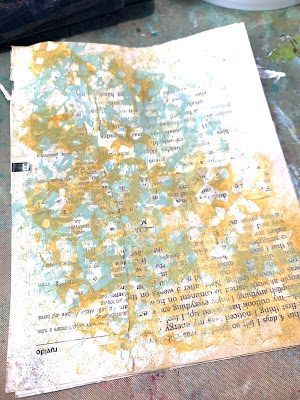StencilGirl® Talk
A blog for the StencilGirl® Product line owned by Mary Beth Shaw for people who love stencils like we love stencils.
Friday, June 27, 2025
Creating layers ~ a resist background
Wednesday, June 11, 2025
Stencil Magic with Sand Paper & Wax Crayons
Hello! Happy June and Happy Summer!
Tina Walker here with a fun, super easy, and super duper way to use your StencilGirl® stencils to create soft, subtle textures and backgrounds.
Grab your favorite stencils, (I'm going to feature some of my very own designs), a sanding block (fine grit), vintage & magazine papers, and a white or clear wax crayon!
A few tips before we start...
1. When selecting stencils, stencils with larger, open designs work best. But experiment with what you have. If you are gentle enough, all stencils will work, but with various looks.
2. When selecting images from your papers, images with dark or solid backgrounds work best for sanding. Images with white or empty backgrounds, work best for wax rubbings. Again, experiment with different images for different effects.
3. Effects will be soft and subtle. Use the techniques to enhance your images and create a play on pattern and texture.
Let's start with the sanding block technique.
Place your stencil underneath your paper. I am going to sand the grassy background of this page so I will ensure the stencil is placed under that portion.
GENTLY, I'll repeat....GENTLY rub the paper with your sanding block to reveal the stenciled design below. Depending on the color of the paper and the design, you should see full or hints of the appearing stencil. Experiment with different papers and colors (using the same stencil) to see the variety.
Here you can see the different looks you can achieve by varying the background color, design, and stencil.
Stencils Used:
Now let's spread those creative wings and try wax rubbings with various papers. Again, the finished look will be delicate, soft, and subtle.
Lighter, blank papers work best -
Place your stencil under your paper and GENTLY rub a white or colorless wax crayon (or wax candle) over the stenciled portion.
I like to add watercolors on top of the rubbed section. The wax acts as a resist which creates interesting looks.
I did not prep the paper with gesso, but I urge you to experiment with this to see what various results you can achieve.
You can also do this technique with plain copy paper. The bright white backgrounds works beautifully for this technique.
Stencils Used:
Here's a peek at some of my experimentation's....
Additional stencils shown here:
I hope you will give these 2 techniques a GO!!!
As a special THANK YOU and a chance to pick up my stencils at 20%, use COUPON CODE 'TW20'. The discount code is good until 6/24/25. ENJOY!
Happy Creating!
XOXO Tina
Wednesday, May 14, 2025
Painterly Art Tags with a side of Collage Paper
Acrylic Paint
Paintbrushes
Art Sponge
Scissors
Pencil
Ribbon Scraps
Recycled Safety Pin
Tracing paper
Shipping Tag
Watercolor Paint
Water Mister
Hole Punch
 |
| Painterly Art Tag Supplies |
Once the tag is dry, position a portion of the Vintage Rose Floral Sampler Stencil (LL1027) over the tag. Using a sponge or flat brush, tap your lightest value of color (or white) through the stencil. Carefully lift the stencil off the tag. Set the tag aside to dry and clean your stencil.
Spritz a piece of tracing paper with water. For a dreamy watery effect, like the one I made, more is better. For crisp images less is better.
















































